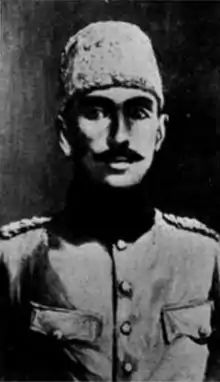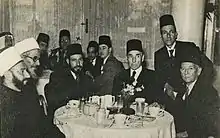Aziz Ali al-Misri
Aziz Ali al-Misri (1879 – 15 June 1965) was an Egyptian chief of staff and politician. He co-founded of al-Qahtaniyya and al-‘Ahd (The Covenant).
'Aziz 'Ali al-Misri | |
|---|---|
 | |
| Born | 1879 |
| Died | June 15, 1965 (aged 85–86) Cairo, Egypt |
| Nationality | Ottoman Empire; Egyptian circassian |
| Known for | co-founder of Al-Qahtaniyya and Covenant Society; Arab Revolt |
Early life and background
Al-Misri (or al-Masri) was born in Cairo of Circassian (Ubykh and Bzedugs) ancestry. His father, Zakariya, and previous relatives on his father’s side of the family were Circassian, with the original family name before having moved to Irak and then Egypt: Shkhaplhy (Adyghe: Шъхьаплъы, pronounced and written in English Shapli as did his son Omar in the USA). He was conscious of this fact throughout his lifetime. His half sister Aziza (1872-1936), from their common mother Chafika Siouk Mukbel, was the wife of Aly Pasha Youssef Ramzy Zulficar a governor of Cairo.[1]
Al-Misri trained at the Ottoman Military Academy, where he graduated in 1901, and moved onto the Staff College of the Ottoman Army. He appreciated 19th century German military school. Shortly after, he became an officer in the Ottoman army. His first assignment as a member of the military was in Ottoman Vardar Macedonia. During his stay in the Balkans, al-Misri joined the ranks of the Committee of Union and Progress (CUP), at first a secret organization, more commonly known as the Young Turks. It later became a political group that would eventually take control of the country in 1908.
Political career
Early years
In the formative constitutional years of the Ottoman Empire, al-Misri remained an advocate for Ottoman unity. He was a political moderate who wanted the three main political groups, Ottomanist, pan-Islamic, and Egyptian and Arab nationalist,[2] to exist in cooperation. "He had come to the conclusion that in so composite a society as the Ottoman Empire the best way to maintain its integrity was not by attempting to suppress nationalities but by recognizing them, each as an autonomous unit within the Ottoman superstructure."[3] In 1911, Al-Masri helped mediate a treaty between the Imam Yahya of Yemen and Izzat Pasha, the commander of the Ottoman campaign.[4]
Fallout with the Committee of Union and Progress
Al-Misri's mixed ethnic background, combined with his sense of political moderation made him an easy target for the CUP. It also made him a popular hero among the Arab political groups and he was labeled as sympathetic to the cause of Arab nationalists. During the Italian invasion and occupation (1911-1912) of Tripolitana and Cyrenaica (modern Libya) he took a leading part in organising resistance in Benghazi with Suleiman al-Askary as his deputy. He developed the system of using tribal tactics with regular combat tactics; a system he later recommended in the Arab Revolt (1916-1918) cf. below and reference n°9. The staff under the orders of general Enver Bey (to become pasha) also included Mustafa Kemal. Probably the greatest reason for his falling out with the CUP was a clash with Enver Pasha. The roots of this quarrel seem to be a mutual dislike for one another, in particular as Aziz opposed the oppressive attitude of the CUP towards minorities. Arab revolutionaries joined in on al-Misri's admonition of Enver Pasha. "There is no doubt that Aziz Ali Bey has been one of the leading spirits in a group of young Arabs".[5] His personality was abrasive and unyielding, and both the CUP and Arab political groups played on this to their advantage.
In April 1914, al-Misri was arrested and removed from Istanbul by the CUP. Although this was not the direct doing of Enver Pasha, it gave him the impetus to "denounce al-Misri as an Arab revolutionary leader who sough an Arab rebellion, and much to al-Misri’s dismay, it put him in a somewhat different light in the eyes of those working for Turko-Arab collaboration."[6] Al-Misri's arrest coincided with a massive purge of Arab officers in the Turkish army. His trial caused effervescence in Egypt and Syria and the British Ambassador in Constantinople (Sir L. Mallet) intervened with the Porte in his favour.[7] Aziz al-Misri went back to Egypt.[8]
Role in the Arab Revolt
In 1914 he begun working under Sharif Husayn, the Sharif of Mecca. In his Seven Pillars of Wisdom (Chapter viii), T.E. Lawrence recorded that on board ship, en route for Jiddah, Ronald Storrs "turned twice around the decks, sniffed, ‘No one worth talking to’, and sat down in one of the two comfortable armchairs, to begin a discussion of Debussy with Aziz el Masri (in the other). Aziz, the Arab-Circassian ex-colonel in the Turkish Army, now general in the Sherifian Army, was on his way to discuss with the Emir of Mecca the equipment and standing of the Arab regulars he was forming at Rabegh. A few minutes later they had left Debussy, and were depreciating Wagner: Aziz in fluent German, and Storrs in German, French and Arabic."
Aziz al-Misri played a prominent role in the early stages of the Arab Revolt. This was an attempt by Sharif Husayn, with British support suggested among others by Aziz al-Misri, to create an independent Arab state, free from Ottoman control. Using a mix of Bedouin volunteers, Arab officers and Arab Ottoman deserters who wanted to join the Revolt, Al-Masry created, out of this total force of 6,000, three infantry brigades, a mounted brigade, engineering unit, and three different artillery groups made up of a patchwork of varying cannon and heavy caliber machine guns. British and French officers also provided technical military advice, among whom T.E. Lawrence (Lawrence of Arabia).[9]
Having understood that France and Great Britain were in fact negotiating spheres of influence in the region, Aziz al-Misri encouraged the Sharif to be more independent. He fell out of touch with Sharif Husayn, came back to Egypt in February 1917 and then travelled to Spain and Germany.[10]
Later military career in Egypt

Back to Egypt, Aziz al-Misri married Frances (born Smith) an American and they had a son Omar (Cairo 1930 - Williamstown, USA 2010). From 1927 to 1935, he directed the Cairo Police Academy.[11] By decision of his father King Fouad, the crown prince Farouk, attended (from September 1935 to May 1936) the Royal Military Academy in Woolwich under the guardianship of Aziz Pacha el-Masry and Ahmed Hassanein Pacha. Aziz el-Misry was then a member of the regency council assisting Farouk until the latter became officially King of Egypt in July 1937. In 1938, Aziz al-Misry became inspector general of the Egyptian army. In 1939, Premier Ali Mahir named him chief of staff, but he was dismissed from that post in 1940 at Britain's insistence. He deserted the Egyptian army and tried to reach the Axis forces in the Libyan desert but was caught and put into trial in 1941. Anwar Sadat had a part in this attempt.[12] Aziz al-Misry was released in 1942 among others as he revealed having informed Colonel Cudbert Thornhill (British Special Operations Executive officer) of his flight to reach Iraq.[13] In the cosmopolitan society of Cairo and with his wide culture and religious tolerance, Aziz al-Misri had, in all communities, many acquaintances and some friends.[14]
Post-1952 Revolution and death
After al-Misri had helped the Free Officers prepare for the revolution of 1952, they named him ambassador to Moscow in 1953 and considered making him president in place of Muhammad Naguib, but he retired in 1954.
He died the 15th of June 1965 in Cairo. Egypt honored him with State funeral.[15]
Legacy

One of the longest streets in Greater Cairo was named after him.
References
- Their son, Youssef Zulficar Pasha, became the father of Farida first wife of King Farouk
- Including Nuri al-Said he introduced to the British as soon as 1914 cf.Proconsul to the Middle East: Sir Percy Cox and the End of Empire John Townsend I.B.Tauris, 2010 - 272 pages, p.73
- Khadduri, Majid (1973). Arab Contemporaries: The Role of Personalities in Politics. Baltimore: Johns Hopkins University Press. p. 10.
- "Al-Ahram Weekly | Chronicles |". weekly.ahram.org.eg. Retrieved 2016-11-19.
- Sir L. Mallet to Sir Edward Grey.(l), F.O. 9033/7963/14/44., (No. 117.). Constantinople D. February 24, 1914.R. March 2, 1914. cf.http://www.gwpda.org/1914m/arabetuk.html
- Khadduri (1973), p. 11.
- The Last Years of Peace (British Documents on the Origins of the War, 1898-1914, G. P. Gooch and Harold Temperley, eds. with the assistance of Lillian M. Penson, PhD, 1938), Volume X, Part II: pps 824-838. cf. https://wwi.lib.byu.edu/index.php/British_Imperial_Connexions_to_the_Arab_National_Movement
- Aziz Bandarli and Umberto Dorés, the pioneering photographers resident in Alexandria produce one of the first Egyptian documentaries on "The Reception of the National Hero: Aziz Bey El Masri, Commander in Chief of the Egyptian Army." cf. http://www.bibalex.org/alexcinema/films/Early_Films.html
- Stewart, Desmond (1977). T. E. Lawrence: A New Biography. Harper & Row. pp. 148 to 175. ISBN 978-0060141233.
- Tauber, Eliezer (1993). The Arab Movements in World War I. London 1993. Frank Cass. pp. 97–98. ISBN 9780714640839.
- "عزيز المصرى - فاروق مصر". www.faroukmisr.net. Retrieved 2016-11-19.
- Sadat, Anwar (1978). In Search of Identity: An Autobiography. Harper & Row. ISBN 9780060137427.
- Wylie, Neville (2007). The Politics and Strategy of Clandestine War: Special Operations Executive, 1940-1946. Routledge. pp. 151. ISBN 978-0415391108.
- Kelly, Saul (2009). The Lost Oasis: The True Story Behind "The English Patient". Basic Books. pp. Chapter 8: Plan El-Masri. ISBN 978-0813342580.
- United Arab Republic President Gamal Abdel Nasser at the funeral of the Egyptian army chief Aziz El Masry.